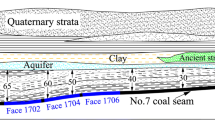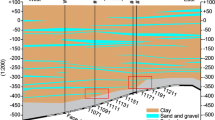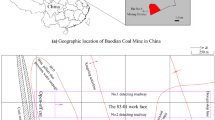Abstract
During longwall top coal caving mining of shallow buried thin bedrock and thick coal seams, penetrating fractures may form in the rock strata above the roof, causing an inrush of water and sand at the working face. The 507-working face of the Madiliang Coal Mine in Inner Mongolia, China, is a shallow buried thin bedrock and thick coal seam, mined by longwall top-coal caving mining. The field exploration results showed that the immediate roof consists of a layer of yellow mud within 400 m of the working face. The yellow mud has greater fluidity when encountering water and sits below a layer of yellow sandstone, which has a high risk of inrushing water and mud. Considering the roof lithology, longwall top coal caving mining characteristics, the fluidity of yellow mud, and the progressive failure of the coal seam, the particle flow code in two dimensions was used to establish the longwall top coal caving mining numerical model and analysed the movement characteristics of the top coal and yellow mud under different top coal thicknesses. Based on the results of field investigations and numerical calculations, a work-safe mining scheme was proposed, where the working face retains 4 m of top coal for mining. When the top coal thickness is less than 4 m, shearer cutting floor rock mining. A real-time mine pressure monitoring system was also established. The field application showed no incidents of water and mud inrush during the recovery period, which protects the working face.















Similar content being viewed by others
References
Alehossein H, Poulsen BA (2010) Stress analysis of longwall top coal caving. Int J Rock Mech Min 47(1):30–41
Bai Q, Tu S, Wang F, Zhang C (2017) Field and numerical investigations of gateroad system failure induced by hard roofs in a longwall top coal caving face. Int J Coal Geol 173176–173199
Bai Q, Tu S, Zhang C, Zhu D (2016) Discrete element modeling of progressive failure in a wide coal roadway from water-rich roofs. Int J Coal Geol 167215–167229
Celik A, Ozcelik Y (2021) Investigation of the efficiency of longwall top coal caving method applied by forming a face in horizontal thickness of the seam in steeply inclined thick coal seams by using a physical model. Int J Rock Mech Min 148:(104917)
Chen B, Zhang S, Li Y, Li J (2021) Experimental study on water and sand inrush of mining cracks in loose layers with different clay contents. B Eng Geol Environ 80(1):663–678
Cheng Y, Jiao Y, Tan F (2019) Numerical and experimental study on the cracking behavior of marble with en-echelon flaws. Rock Mech Rock Eng 52(11):4319–4338
Fan G, Zhang D, Zhang S, Zhang C (2018) Assessment and prevention of water and sand inrush associated with coal mining under a water-filled buried gully: a case study. Mine Water Environ 37(3):565–576
Gao F, Stead D (2013) Discrete element modelling of cutter roof failure in coal mine roadways. Int J Coal Geol 116158–116171
Guo W, Zhao G, Bai E, Guo M, Wang Y (2021) Effect of overburden bending deformation and alluvium mechanical parameters on surface subsidence due to longwall mining. B Eng Geol Environ 80(3):2751–2764
He X, Zhao Y, Yang K, Zhang C, Han P (2021) Development and formation of ground fissures induced by an ultra large mining height longwall panel in Shendong mining area. B Eng Geol Environ 80(10):7879–7898
Hu Y, Li W, Wang Q, Liu S, Wang Z (2019) Evolution of floor water inrush from a structural fractured zone with confined water. Mine Water Environ 38(2):252–260
Huang Y, Yang S, Ranjith P G, Zhao J (2017) Strength failure behavior and crack evolution mechanism of granite containing pre-existing non-coplanar holes: experimental study and particle flow modeling. Comput Geotech 88182–88198
Kang H, Lou J, Gao F, Yang J, Li J (2018) A physical and numerical investigation of sudden massive roof collapse during longwall coal retreat mining. Int J Coal Geol 18825–18836
Kasyap S S, He H, Senetakis K (2022) 3D DEM analysis of analogue proppant-fractured rock system interaction. B Eng Geol Environ 81(311)
Kasyap S S, Senetakis K (2022) Small-scale size effects on the shearing behavior and sliding stiffness reduction-displacement curves of rock-plastic gouge simulant under low normal stresses. J Struct Geol 157(104553)
Kong D, Cheng Z, Zheng S (2019) Study on the failure mechanism and stability control measures in a large-cutting-height coal mining face with a deep-buried seam. B Eng Geol Environ 78(8):6143–6157
Le T D, Bui X N (2020) Effect of key parameters on top coal first caving and roof first weighting in longwall top coal caving: a case study. Int J Geomech 20(040200375)
Le T D, Oh J, Hebblewhite B, Zhang C, Mitra R (2018) A discontinuum modelling approach for investigation of longwall top coal caving mechanisms. Int J Rock Mech Min 10684–10695
Lei S, Feng X, Wang S (2021) Water-sand mixture inrush through weakly cemented overburden at a shallow depth in the Yili coal mining area. Arab J Geosci 14(110312)
Li A, Ji B N, Ma Q, Liu C, Wang F, Ma L, Mu P, Mou L, Yang Y, Ding X (2021) Design of longwall coal pillar for the prevention of water inrush from the seam floor with through fault. Geofluids 2021(5536235)
Li S, Fan C, Luo M, Yang Z, Lan T, Zhang H (2017) Structure and deformation measurements of shallow overburden during top coal caving longwall mining. Int J Min Sci Techno 27(6):1081–1085
Liu W, Yuan W, Yan Y, Wang X (2019a) Analysis of acoustic emission characteristics and damage constitutive model of coal-rock combined body based on particle flow code. Symmetry-Basel 11(10408)
Liu Y, Yuan S, Yang B, Liu J, Ye Z (2019b) Predicting the height of the water-conducting fractured zone using multiple regression analysis and GIS. Environ Earth Sci 78(42214)
Lotidis MA, Nomikos PP, Sofianos AI (2019) Numerical study of the fracturing process in marble and plaster hollow plate specimens subjected to uniaxial compression. Rock Mech Rock Eng 52(11):4361–4386
Luo L, Kasyap SS, He H, Senetakis K (2022) Laboratory and discrete-based numerical investigation on the collision problem of impactor-block systems with soft-porous and hard-crystalline analog rocks. Int J Numer Anal Met 46(3):594–616
Qian Z, Jiang Z, Guan Y, Yue N (2018) Mechanism and remediation of water and sand inrush induced in an inclined shaft by large-tonnage vehicles. Mine Water Environ 37(4):849–855
Ren J, Wang F, He H, Senetakis K (2022) The tribological behavior of analog mudrock interfaces in dry, water-immersed and guar-gum solution states. Tribol Int 165(107281)
Song Z, Konietzky H (2019) A particle-based numerical investigation on longwall top coal caving mining. Arab J Geosci 12(55618)
Song Z, Konietzky H, Herbst M (2020) Drawing mechanism of fractured top coal in longwall top coal caving. Int J Rock Mech Min 130(104329)
Sui W, Hang Y, Ma L, Wu Z, Zhou Y, Long G, Wei L (2015) Interactions of overburden failure zones due to multiple-seam mining using longwall caving. B Eng Geol Environ 74(3):1019–1035
Wang G, Wu M, Wang R, Xu H, Song X (2017) Height of the mining-induced fractured zone above a coal face. Eng Geol 216140–216152
Wang J, Wei W, Zhang J, Mishra B, Li A (2020) Numerical investigation on the caving mechanism with different standard deviations of top coal block size in LTCC. Int J Min Sci Techno 30(5):583–591
Wang J, Yang S, Li Y, Wei L, Liu H (2014) Caving mechanisms of loose top-coal in longwall top-coal caving mining method. Int J Rock Mech Min 71160–71170
Wang J, Zhang J, Li Z (2016) A new research system for caving mechanism analysis and its application to sublevel top-coal caving mining. Int J Rock Mech Min 88273–88285
Wang Y, Geng F, Yang S, Jing H, Meng B (2019) Numerical simulation of particle migration from crushed sandstones during groundwater inrush. J Hazard Mater 362327–362335
Wu N, Liang Z, Zhou J, Zhang L (2020) Energy evolution characteristics of coal specimens with preformed holes under uniaxial compression. Geomech Eng 20(1):55–66
Xu J, Pu H, Chen J, Sha Z (2021) Experimental study on sand inrush hazard of water-sand two-phase flow in broken rock mass. Geofluids 2021:(5542440)
Xu Y, Luo Y, Li J, Li K, Cao X (2018) Water and sand inrush during mining under thick unconsolidated layers and thin bedrock in the zhaogu no. 1 coal mine, china. Mine Water Environ 37(2SI):336–345
Xu Y, Wu K, Li L, Zhou D, Hu Z (2019) Ground cracks development and characteristics of strata movement under fast excavation: a case study at Bulianta coal mine. China B Eng Geol Environ 78(1):325–340
Xu ZH, Wang WY, Lin P, Xiong Y, Liu ZY, He SJ (2020) A parameter calibration method for PFC simulation: development and a case study of limestone. Geomech Eng 22(1):97–108
Yang S, Zhang J, Chen Y, Song Z (2016a) Effect of upward angle on the drawing mechanism in longwall top-coal caving mining. Int J Rock Mech Min 8592–85101
Yang W, Xia X, Pan B, Gu C, Yue J (2016b) The fuzzy comprehensive evaluation of water and sand inrush risk during underground mining. J Intell Fuzzy Syst 30(4):2289–2295
Yang X, Liu Y J, Xue M, Yang T H, Yang B (2020) Experimental investigation of water-sand mixed fluid initiation and migration in porous skeleton during water and sand inrush. Geofluids 2020:(8679861)
Yoon J (2007) Application of experimental design and optimization to PFC model calibration in uniaxial compression simulation. Int J Rock Mech Min 44(6):871–889
Zhang G, Zhang K, Wang L, Wu Y (2015) Mechanism of water inrush and quicksand movement induced by a borehole and measures for prevention and remediation. B Eng Geol Environ 74(4):1395–1405
Zhang G, Zhang W, Wang H, Cao S, Wu Y, Wang Z (2020a) Research on arch model and numerical simulation of critical water and sand inrush in coal mine near unconsolidated layers. Geofluids (6644849)
Zhang K, Zhang B, Liu J, Ma D, Bai H (2017a) Experiment on seepage property and sand inrush criterion for granular rock mass. Geofluids (UNSP 9352618)
Zhang S, Guo W, Li Y, Sun W, Yin D (2017b) Experimental simulation of fault water inrush channel evolution in a coal mine floor. Mine Water Environ 36(3):443–451
Zhang W, Wang Z, Zhu X, Li W, Gao B, Yu H (2020b) A risk assessment of a water-sand inrush during coal mining under a loose aquifer based on a factor analysis and the Fisher model. J Hydrol Eng 25(040200338)
Zhao X, Wang J, Mei Y (2020) Analytical model of wellbore stability of fractured coal seam considering the effect of cleat filler and analysis of influencing factors. Appl Sci Basel 10(11693)
Acknowledgements
This work was financially supported by the National Natural Science Foundation of China (no. 51874283 and no. 51874285). We would like to thank Editage (www.editage.cn) for English language editing.
Author information
Authors and Affiliations
Corresponding author
Ethics declarations
Competing interest
The authors declare no competing interests.
Rights and permissions
Springer Nature or its licensor holds exclusive rights to this article under a publishing agreement with the author(s) or other rightsholder(s); author self-archiving of the accepted manuscript version of this article is solely governed by the terms of such publishing agreement and applicable law.
About this article
Cite this article
Zhu, L., Yao, Q., Xia, Z. et al. Prevention of water and mud inrush in longwall top coal cave mining under shallow buried thin bedrock. Bull Eng Geol Environ 81, 355 (2022). https://doi.org/10.1007/s10064-022-02846-1
Received:
Accepted:
Published:
DOI: https://doi.org/10.1007/s10064-022-02846-1




